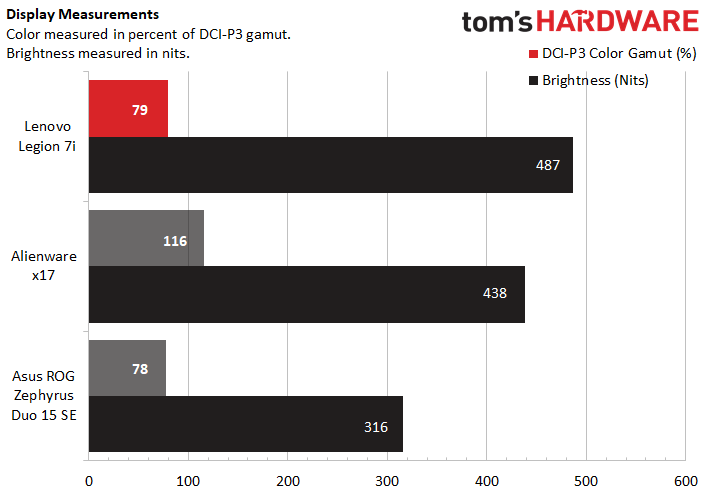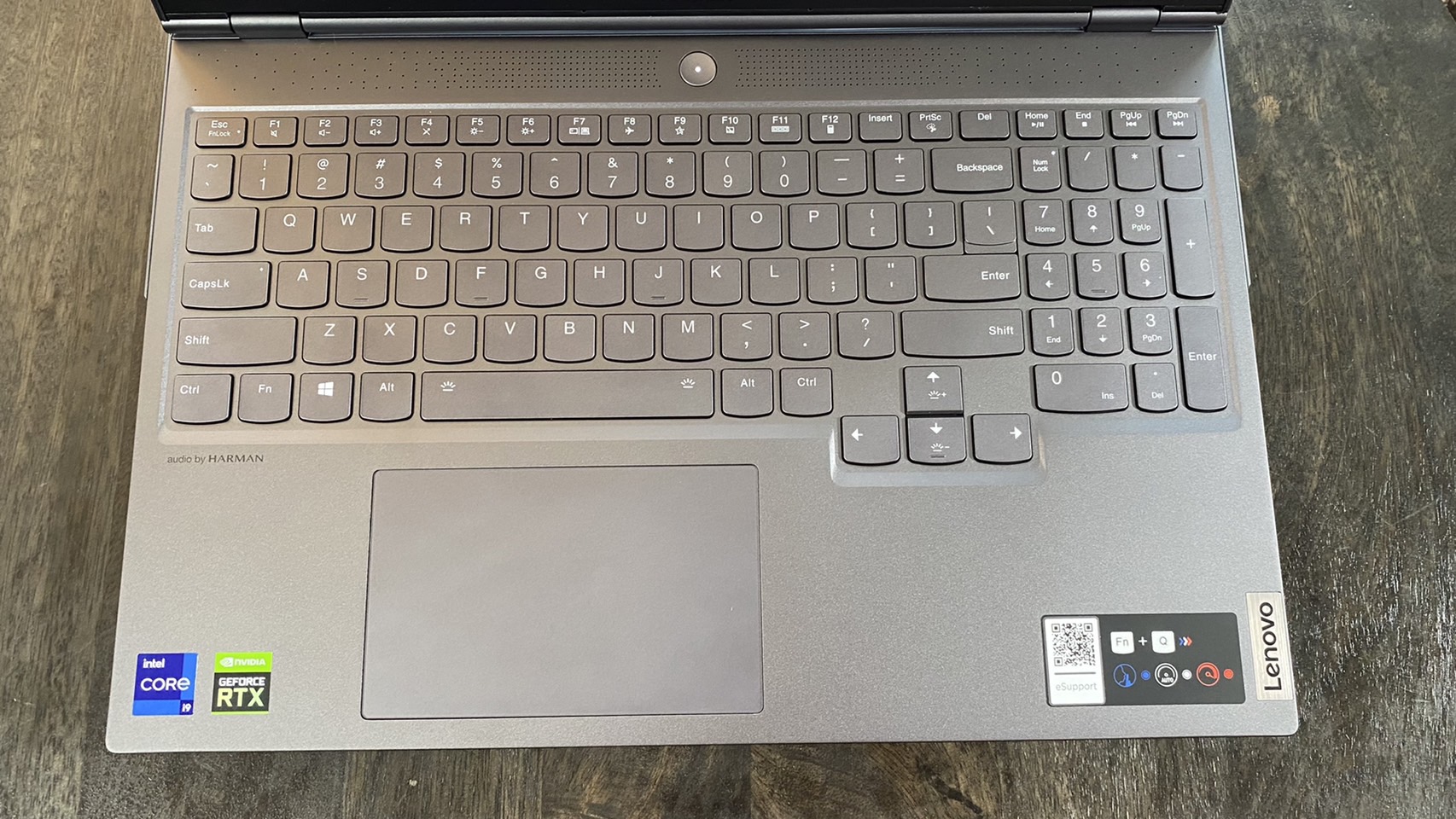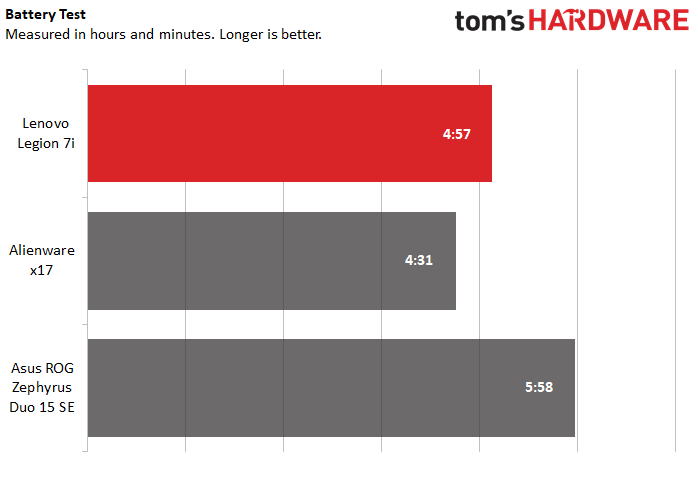Tom's Hardware Verdict
The Lenovo Legion 7i is slick, if not the slickest, plus has leading power for a few hundred dollars less than the competition.
Pros
- +
+ Powerful for gaming
- +
+ Slightly cheaper than competitors
- +
+ Bright screen
- +
+ Comfortable keyboard
- +
+ Clear audio
Cons
- -
Screen suffers from glare
- -
Can run hot
Why you can trust Tom's Hardware
Intel’s 45W Tiger Lake chips and Nvidia’s mobile RTX cards have been around for a while now, but if the Lenovo Legion 7i is anything to go by, they still have untapped potential waiting to be unlocked. This is easily among the most powerful Intel/Nvidia laptops we’ve reviewed yet, and what makes it better is that its lack of lifestyle branding leaves it just a touch cheaper than what you’ll find with competitors like Alienware.
Designed to compete with the best gaming laptops, this is definitely still an expensive PC, and we can’t speak on how configs with lower specs that we didn’t review perform. But for the absolute top of the line, the Lenovo Legion 7i is an excellent option if you’re willing to sacrifice some fashion cred for a machine that’s still plenty slick and packs leading power.
Lenovo Legion 7i Specifications
| CPU | Intel Core i9-11980HK |
| Graphics | Nvidia GeForce RTX 3080 |
| Memory | 32GB DDR4-3200 |
| Storage | 1TB NVMe M.2 SSD |
| Display | 16-inch, 16:10, 2560 x 1600, 165Hz, IPS |
| Networking | 802.11ax Intel Wi-Fi 6, Bluetooth 5.1 |
| Ports | 2x Thunderbolt 4, 1x USB 3.2 Gen 1 Type-C, 3x USB 3.2 Gen 1 Type-A, 1x HDMI 2.1, 1x RJ-45 Ethernet, 1x 3.5mm Headphone/Mic Combo Jack |
| Camera | 720p |
| Battery | 80 Wh |
| Power Adapter | 300W |
| Operating System | Windows 10 Home |
| Dimensions(WxDxH) | 14.17 x 10.23 x 0.92 inches (359.92 x 259.84 x 23.37 mm) |
| Weight | 5.5 pounds (2.49 kg) |
| Price (as configured) | $3,269 |
Lenovo Legion 7i Design
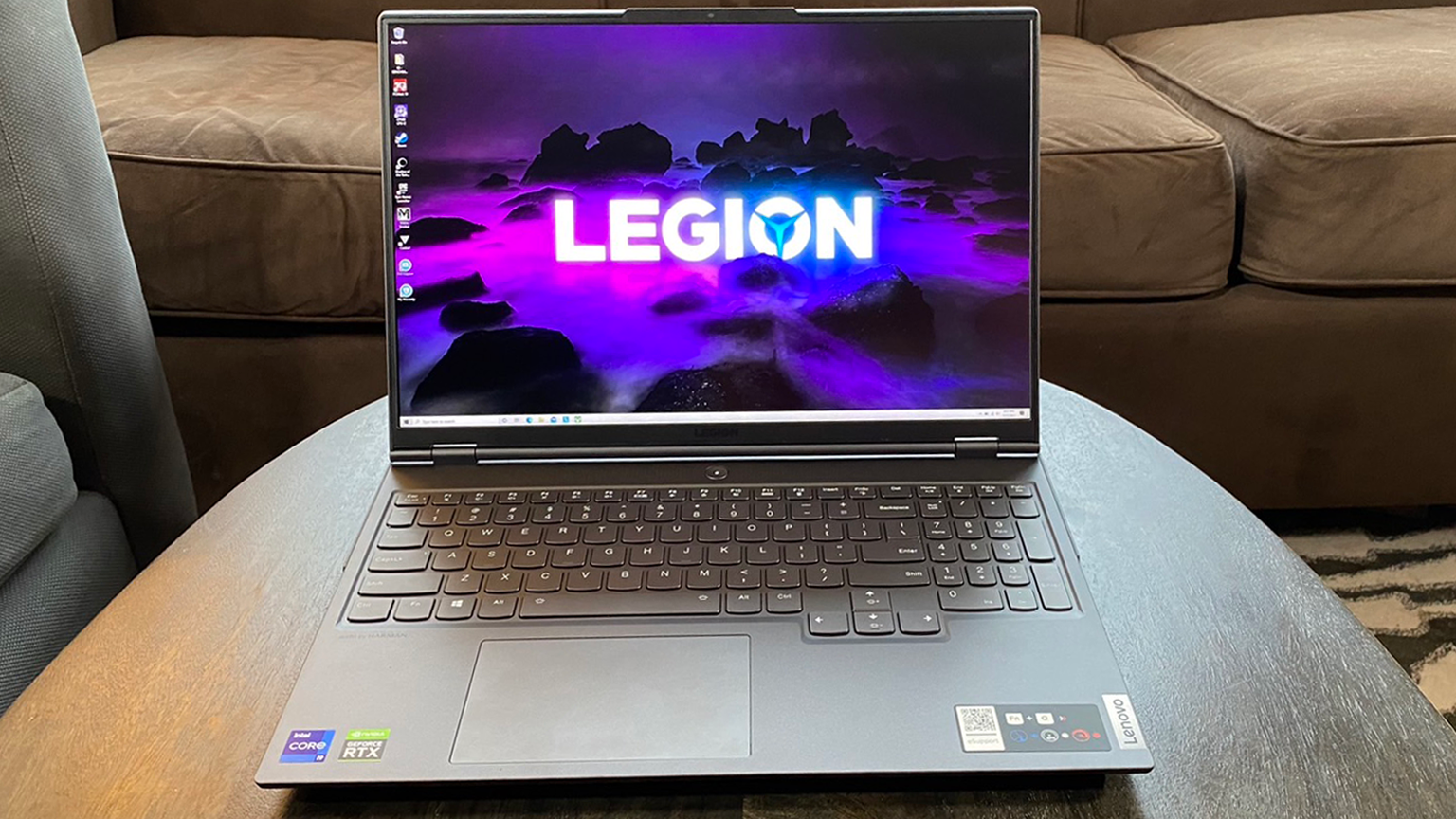
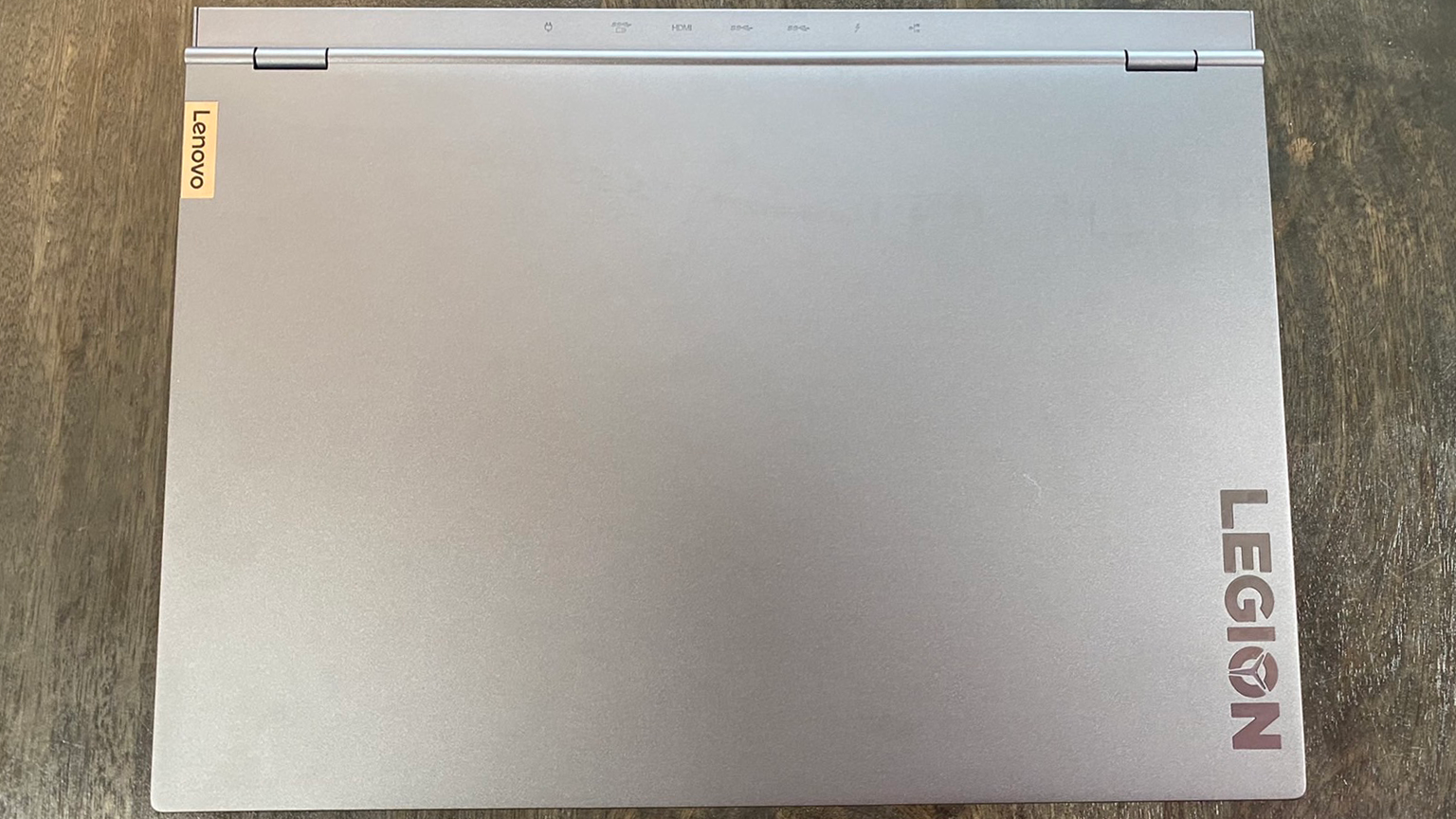
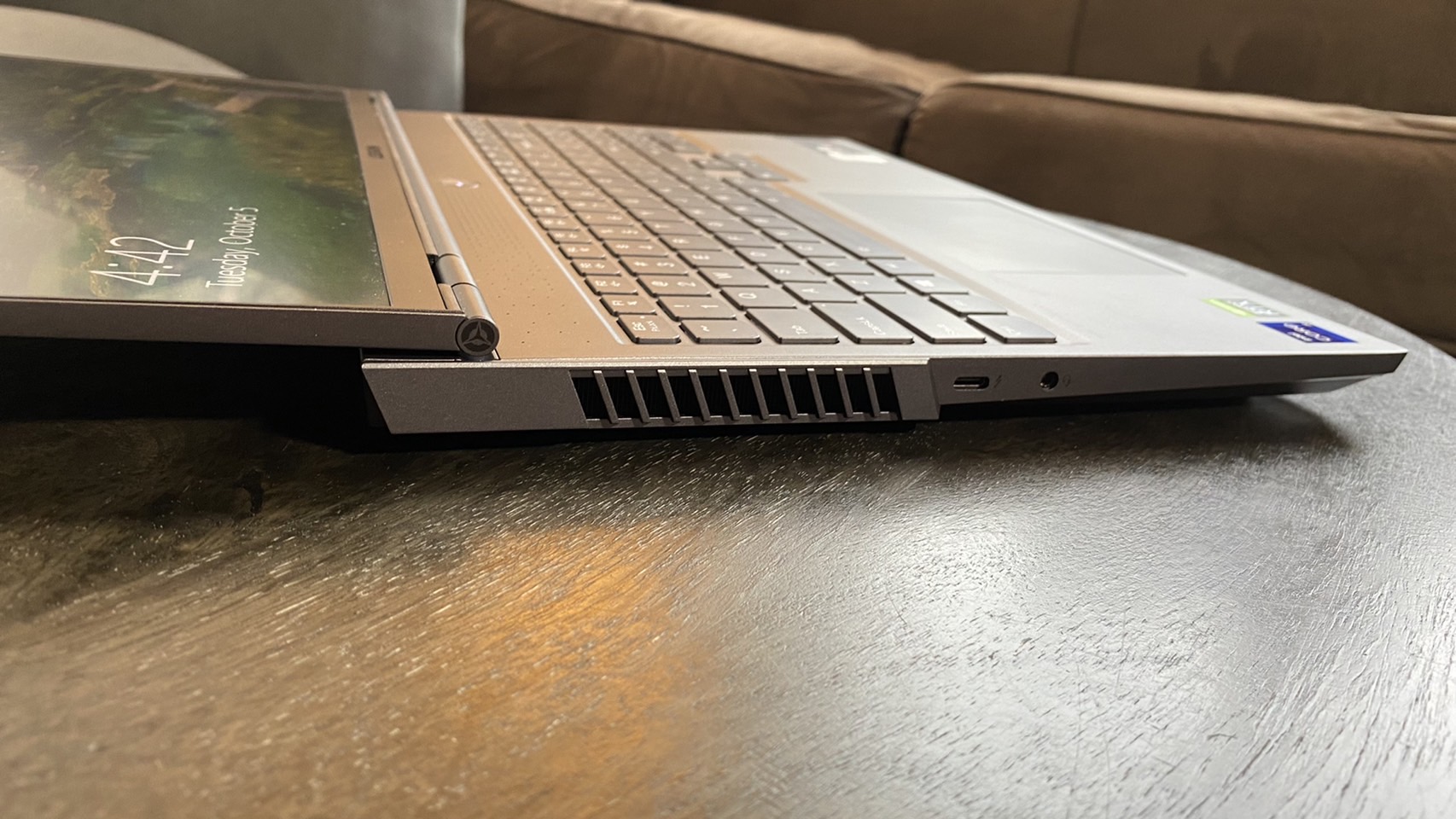
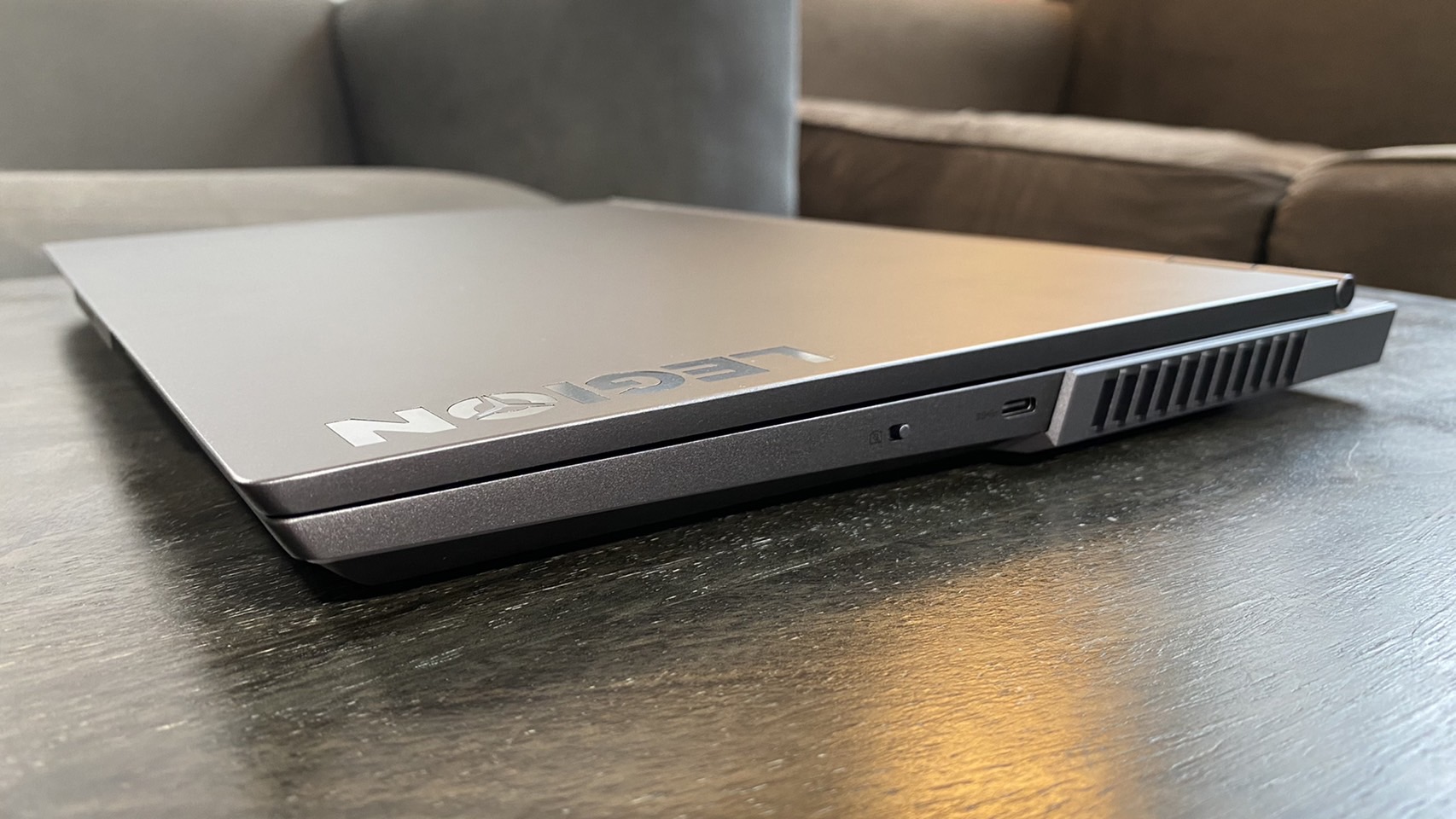

The Lenovo Legion 7i is a flat laptop with a backside that notably stretches past the device’s hinge and houses most of the computer’s ports. Branding is fairly prevalent across the device, and despite the whole machine being coated in a silvery matte metal, it is a fingerprint magnet. It has also got an RGB strip along its bottom, so it can reflect a rainbow aura off your desk.
In other words, it’s not too aesthetically unique from other recent Legion laptops. Maybe its most noticeable feature is its stylish but bulky vents, which sit along the laptop’s sides, under its screen and along its bottom to provide it with plenty of cooling without ruining its slick appeal. Its side vents in particular are large enough that they’re probably a good deal of the reason for this machine’s ports mostly being situated along its back.
Moving beyond looks, this machine is slightly larger than your typical 15-inch laptop, probably in part because of its 16-inch display. For instance, at 14.17 x 10.23 x 0.92 inches, it’s a little thicker than the Asus ROG Zephyrus Duo 15 SE’s 14.1 x 10.6 x 0.80 inches. At the same time, it’s still much smaller (if not thinner) than what you’ll find on 17 inch devices like the Alienware x17, which measures in at 15.72 x 11.79 x 0.84 inches
At 5.5 pounds, this laptop’s weight is roughly on par with the Asus ROG Zephyrus Duo 15 SE’s 5.3 pounds but is much lighter than the Alienware x17’s 7.05 pounds.
The I/O for this laptop is mostly located along its backside. The laptop’s left side has a single Thunderbolt 4 port and 3.5 mm combination microphone/headphone jack, while its right side just has a USB 3.2 Gen 1 Type-C port and a switch for turning physical power to the webcam off. Otherwise, you’ll need to reach behind the screen to find the other Thunderbolt 4 port, the three USB 3.2 Gen 1 Type-A ports, the HDMI 2.1 connection, the RJ-45 ethernet input and the charging cable slot.
Get Tom's Hardware's best news and in-depth reviews, straight to your inbox.
Lenovo Legion 7i Gaming Performance



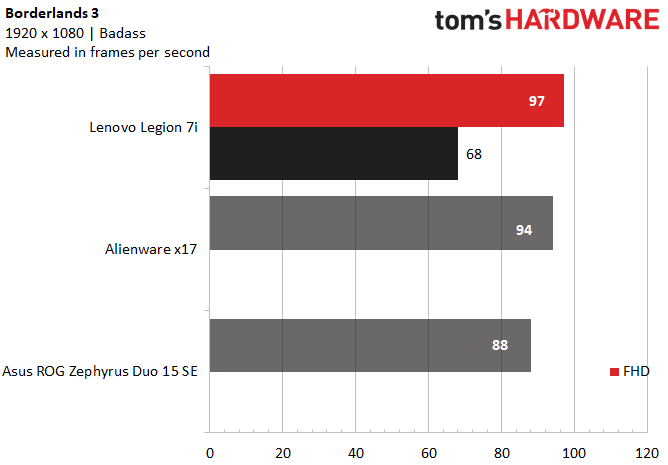
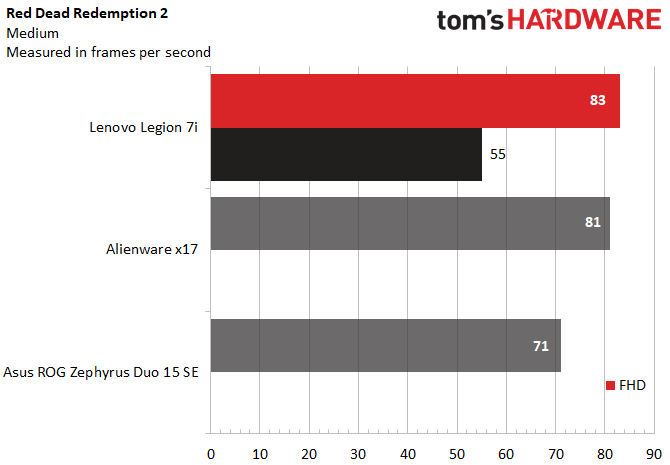
Our configuration of the Lenovo Legion 7i came stacked with just about the most powerful internals an Intel gaming laptop can have, with an Intel Core i9-11980HK CPU, an RTX 3080 mobile GPU and 32GB of DDR4 RAM with a 3200 MHz speed. That GPU had a 165W TGP and a 1,545 MHz boost clock. With specs like these, we consistently got chart-topping performance from this machine versus other high performance RTX 3080 laptops we’ve tested like the Alienware x17 and Asus ROG Zephyrus Duo 15 SE.
For instance, in Shadow of the Tomb Raider’s built-in benchmark running with its highest settings at 1080p, the Legion 7i averaged more than 30 frames more per second than its competition. Its 2560 x 1600p performance was also impressive here, coming in only slightly below its rivals’ 1080p performance.
Grand Theft Auto V and Far Cry: New Dawn also saw the Legion 7i outclassing its competition at 1080p, although not by as wide of a margin. For instance, the Legion’s 1080p Grand Theft Auto V benchmark averaged 139 fps while the Alienware’s averaged 129 fps and the Asus’ averaged 111 fps.
The Legion 7i’s 2560 x 1600 performance in Far Cry: New Dawn is also notable here, as the laptop still pushed out more frames at this higher resolution than its rivals did at 1080p. Specifically, it averaged 99 fps at this resolution while the Alienware averaged 94 fps and the Asus averaged 91 fps. That’s not something we saw in any of the other games we tested, but it’s a good sign regardless.
The Legion 7i’s 2560 x 1600 performance started to significantly drop below the 1080p performance of the laptop’s competitors in the other games we tested, but that’s to be expected. The good news here is that the laptop’s 1080p performance still came in above its rivals in Red Dead Redemption 2 and Borderlands 3, even if just barely. Red Dead Redemption 2’s 1080p benchmark averaged 83 fps on the Legion while it averaged 81 fps on the Alienware and 71 fps and the Asus, for instance.
In other words, there’s no game we ran where the Legion 7i didn’t have the fastest 1080p performance among the laptops we tested.
On an anecdotal note, I also played Control on the Legion 7i for about a half-hour to get a personal feel for what gaming on this laptop is like. With ray tracing off and the game running with high settings, I generally hit between 98 - 108 fps at FHD and between 58 - 65 fps at 2560 x 1600 (depending on how much action was on screen). Turning ray tracing on had me hovering around 66 fps at FHD and 32 fps at 2560 x 1600. During this time, the fans were pretty loud and the vent on the computer’s right-hand side was consistently blowing hot air on my mouse hand. This was a constant across all settings.
We also ran the Legion 7i through Metro: Exodus’ built-in RTX benchmark for 15 runs in a row, to simulate a standard demanding play session. During this test, the Legion 7i’s CPU ran at an average of 4.49 GHz and registered an average temperature of 75.72 degrees Celsius. Its average GPU speed was 1.5 GHz, with an average temperature of 75.85 degrees Celsius. The benchmark itself ran at an average 88 fps throughout this test.
Lenovo Legion 7i Productivity Performance

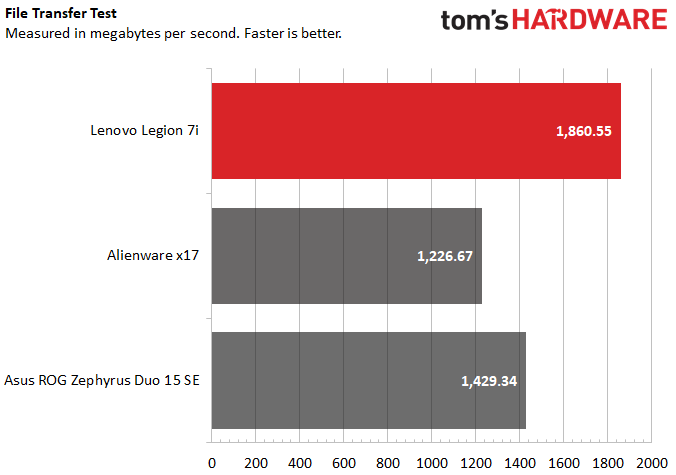

It turns out the best Intel gaming specs you can get on a laptop also make for pretty strong productivity performance, at least against other high-spec gaming laptops. With its 45W Intel Core i9-11980HK CPU, this laptop’s productivity potential easily outclassed the Intel Core i7-11800H on the Alienware x17 configuration we tested and even the AMD Ryzen 9 5900HX on the Asus ROG Zephyrus Duo 15 SE.
Geekbench 5, a synthetic test for measuring general PC performance, saw the Legion 7i scoring far ahead of both of its competitors on both single and multi-core performance. In a hard hit for AMD fans, the Alienware’s i7 CPU actually came closer to the Legion 7i’s performance than the near top-of-the-line 5900HX on the Zephyrus Duo. The Legion 7i scored 1,680 on multi-core tests and the Alienware x17 scored 1,539, but the Zephyrus Duo only scored 1,467.
Our Handbrake video encoding test, where we track how long it takes a PC to transcode a video down from 4K to FHD, also saw similar results. The Legion 7i was slightly faster than the Alienware here, with the former completing the task in 5 minutes and 48 seconds while the latter did so in 5 minutes and 51 seconds. Both were much faster than the Zephyrus Duo, which took 6 minutes and 11 seconds to finish transcoding.
Outside of CPU performance, the Legion 7i also transferred files quickly. In a turnabout, the Zephyrus Duo snagged second place here over the Alienware x17. Still, neither competitor came close to the 1,860.55 MBps we saw on the Legion.
Lenovo Legion 7i Display
The Lenovo Legion 7i sets itself apart with a large 16-inch IPS display that runs at a max resolution of 2560 x 1600 and a max refresh rate of 165Hz. That makes it the latest entry in the 16:10 aspect ratio trend, which gives you extra vertical space for reading web pages, writing documents or coding.
Obviously, I had to test such an impressive screen by watching the trailer for the cinematic masterpiece of our time, Venom: Let There Be Carnage. This actually turned out to be a great decision, since the trailer’s many blacks looked especially deep on this screen while Carnage’s rippling red muscles were still vivid on it. Viewing angles were generous at max brightness, with the picture holding up until around 75 degrees away from the screen. That said, I did notice heavy glare during some of the movie’s darker scenes, either from my office’s window or from ambient light in my environment. And there’s a lot of them in that movie.
That’s a bit of a shame, since this display registered nearly 500 nits of average brightness in our lab. That’s a little ahead of other premium competitors like the Alienware x17, and well ahead of laptops like the Asus ROG Zephyrus Duo 15 SE.
DCI-P3 color was a bit more standard on this laptop, with its 79% coverage being roughly even with the Zephyrus Duo’s 78% but well behind the Alienware x17’s 116%.
Lenovo Legion 7i Keyboard and Touchpad
The Lenovo Legion 7i comes with a full per-key RGB keyboard complete with a number pad, a large touchpad and Lenovo style keycaps. It doesn’t quite live up to what you’ll find on most ThinkPads, but you can still see Lenovo’s expertise with keyboards in play here.
On 10fastfingers.com, I easily hit between 76 to 81 words per minute across my many attempts, which is about my standard. Travel distance felt unremarkable, but the curved bottoms on the keycaps made finding my way around the keyboard by touch a bit more approachable. Presses also felt springy and comfortable, exerting little strain on my fingertips. I do miss the slight concave indentation that ThinkPad keycaps have here, but I can also see how your finger sinking into a key could make twitchy inputs in games more of a hassle.
What isn’t a hassle is the large, 4.7 x 3-inch touchpad. Its smooth, glass surface makes for easy and comfortable cursor control, and I had no problems inputting multi-touch gestures like scrolling with two fingers and switching apps with three fingers.
Lenovo Legion 7i Audio
The Lenovo Legion 7i comes with two bottom firing speakers designed in collaboration with Harman. In my experience, these speakers were loud and produced clear, crisp audio that wasn’t too dissimilar to what I might hear on my Sennheiser headphones.
When I listened to Bad Habits by Ed Sheeran on these speakers, I reached easily audible volume at around 14%, which became comfortably loud at around 36%. Pushing the volume all the way to 100% was completely unnecessary but filled my entire two bedroom apartment with sound without issue.
I could easily make out the song’s vocals, high notes and even bass throughout my whole listening experience, without any hint of tinniness and with virtually no lost information.
Nahimic audio software also comes on this laptop, with settings to optimize your speakers for music, movies, gaming and communication. Music was, of course, the best preset for this test, but each has its strengths and weaknesses, adjusting bass and treble to best fit the task at hand. The movie and gaming presets also have software centric surround sound, which worked well for me so long as I kept my head directly in front of the laptop’s screen.
Lenovo Legion 7i Upgradeability


The Lenovo Legion 7i is not difficult to open up or upgrade. Just unscrew the 10 Phillips head screws on the laptop’s bottom (I used a PH000 screw bit) and gently pry off the case to access its components. Once inside, you’ll see three bits of removable shielding over the components you can swap out. You can just pull off the RAM shielding with your fingertips, but you’ll have to unscrew 3 screws each (I used a PH000 bit here as well) for the M.2 SSD shielding.
After the shields are removed, you’ll have access to the two pre-installed sticks of RAM, the pre-installed M.2 SSD, an open M.2 SSD slot (if both slots aren't full in your configuration) and the networking chip.
Lenovo Legion 7i Battery Life
To simulate an extended multitasking work session, our battery test continually streams video, browses the web and runs OpenGL tests over Wi-Fi at 150 nits of brightness.
The Lenovo Legion 7i had a battery life of about 5 hours on our in-house battery test, which is within expectations for a gaming laptop with these kinds of specs. For instance, the Alienware x17 is another Intel Core i9/RTX 3080 laptop that actually had about a half hour less battery life on the same test. That said, we do occasionally see exceptions, such as the 5:58 battery life we saw on the AMD-powered Asus ROG Zephyrus Duo 15 SE. While we got those numbers with just one of that laptop’s two displays turned on, the Zephyrus only had 5 fewer minutes of battery life than the Legion when we tested it again with both displays running.
To simulate an extended multitasking work session, our battery test continually streams video, browses the web and runs OpenGL tests over Wi-Fi at 150 nits of brightness.
Lenovo Legion 7i Heat
The Lenovo Legion 7i’s heat was congregated mostly near its hinge when we took its temperature, which was during the 11th of 15 consecutive Metro: Exodus benchmark runs set to the RTX preset. Temperatures topped out at 53.2 degrees Celsius (127.76 degrees Fahrenheit), with the hottest point on the laptop being the center of the hinge. Touchpoints such as the center of the keyboard (between the G and H keys) ran closer to 46.9 degrees Celsius (116.42 degrees Fahrenheit).
This is fairly toasty, even for a gaming computer, and it means fans were running at full force during testing. The laptop’s side vents, which are unfortunately located close to where your mouse hand might be, were also blasting out hot air at this time.
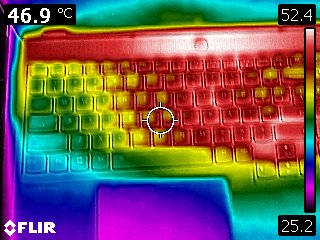
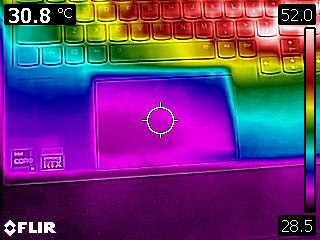
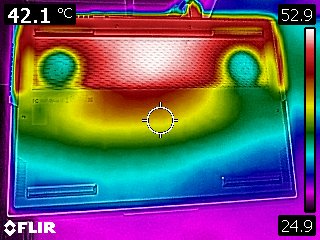
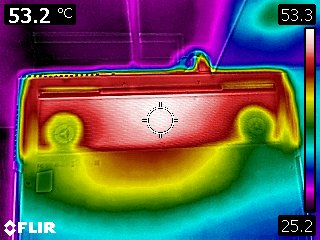
Lenovo Legion 7i Webcam
The Lenovo Legion 7i has a 720p webcam that accurately captures colors and details but tends to produce fuzzy pictures in either dim or oversaturated conditions. It’s unfortunately not quite up to part with other Lenovo webcams, in that it doesn’t have a physical camera shutter. There is a toggle on the right hand side of the laptop for physically cutting off the power to the webcam.
This laptop also comes with Tobii Experience, an eye tracking program that uses the built-in webcam to add bonus features to games, like having the HUD disappear when you’re not looking at it. However, this is a software dependent feature, and the Legion 7i’s webcam doesn’t have eye tracking tech built into it.



Lenovo Legion 7i Software and Warranty
Lenovo tends to avoid bloatware with its laptops, and that’s no different here. You’ll find a number of utility programs on the Lenovo Legion 7i, but aside from typical Windows 10 pack-ins like Spotify and Microsoft Solitaire Collection, the only arguable bloat here is Tobii experience. This is an eye tracking program that’s supposed to help make gaming more immersive by letting you aim or move the camera with your eyes, on top of other features like having the HUD fade away when you’re not looking at it. It might be fun to toy with if you play any of its supported games, but you otherwise won’t get much use out of it. It’s also entirely software dependent, so you can easily download the software from Tobii’s site, with alternate builds being available for use with Alienware, Acer and MSI laptops.
As far as utility apps go, you’ll get Dolby Vision and X-Rite Color Assistant for adjusting your picture, plus Nahimic for adjusting your sound. Lenovo Welcome helps you set up your computer with recommended apps and settings based on what your primary use case for it is, and Lenovo Vantage is where you’ll view your thermals, update your drivers, set up macros for your numpad, view CPU usage and the like. Finally, there’s Lenovo hotkeys, an app that’s inexplicably separate from Vantage and lets you set up various function key shortcuts for system features, like being able to adjust the refresh rate of your display with a simple Fn + R command.
Lenovo Legion 7i Configurations
The Lenovo Legion 7i starts at $1,799, although the configuration we reviewed came with top-end components that pushed the price closer to $3,269. Those include an Intel Core i9-11980HK processor, an RTX 3080 GPU, 32GB of DDR4 RAM and a 1TB M.2 SSD.
Our review laptop also came with a 16-inch 2560 x 1600 IPS screen with a 165 Hz refresh rate, as do all other configurations for this laptop.
Speaking of other configurations, the starting configuration bumps you down to an Intel Core i7-11800H CPU, an RTX 3060 GPU, 16GB of RAM and a 512GB M.2 SSD. There’s also two middle-of-the-road configurations listed on Lenovo’s site, one of which bumps up the starting config’s SSD to 1TB and costs $1,969. The other has an i7-11800H CPU, an RTX 3080, 32GB of RAM and a 1TB SSD and costs $2,899.
You can also customize your own build, mixing and matching select specs from the other configurations.
Bottom Line
With its max specs, the Lenovo Legion 7i is about as powerful as you can get for an Intel gaming build, even when compared against similarly specced but more expensive laptops like the Alienware x17. Its aesthetics might not quite live up to that laptop’s fancy design and it lacks the bells and whistles of rivals like the AMD-powered Asus ROG Zephyrus Duo 15 SE. However, the screen is still bright, the audio is clear, the case feels sturdy and the keyboard has Lenovo’s typical brilliance.
While it’s still a punch to the wallet at $3,269, the configuration we reviewed isn’t just more powerful than the competition, but it’s also more affordable. Both of the laptops we tested this machine against cost closer to $3,600. You might want to consider either of those alternatives if you’re opting for cheaper specs, since the performance games will probably even out and those computers are arguably a touch more premium elsewhere— though perhaps a little too flashy for some. But for performance that’s the best of the best and a body that’s still above average, the Legion 7i is your best bet for now.
Michelle Ehrhardt is an editor at Tom's Hardware. She's been following tech since her family got a Gateway running Windows 95, and is now on her third custom-built system. Her work has been published in publications like Paste, The Atlantic, and Kill Screen, just to name a few. She also holds a master's degree in game design from NYU.
-
Tom Sunday Yes its a punch to the wallet at $3,269 for the configuration as reviewed. I am just a forklift driver at Walmart on the third shift and will never be able to afford these kind of $$$. Probably no more than 0.2% of all the people can really afford the Legion as proffered. Surely this tech site is not devoted only for the upper priveledged view. Thus for me this review shouldn't even be here as it is not reality.Reply -
JWNoctis FWIW their own Legion 5 Pro gives 90%+ of the graphics and processor performance for less than 60% of the listed price. Cost efficiency drops fast at this range.Reply -
apw100 ReplyJWNoctis said:FWIW their own Legion 5 Pro gives 90%+ of the graphics and processor performance for less than 60% of the listed price. Cost efficiency drops fast at this range.
The i9 model isn't worth it. I bought the i7 version (same specs otherwise) and paid $2500 ($2700 after tax). It's easy to use the Intel Extreme Tuning Utility to undervolt and overclock the i7 to achieve better than i9 results. Check out Tally Ho Tech's video... NuhpG_x_lOg:307View: https://www.youtube.com/watch?v=NuhpG_x_lOg&t=307s -
Angstromm Thank you for the fulsome review, appreciate it!Reply
There are a couple of critical (to me) pieces of info missing in the review:
1. Only one of the two M.2 slots supports PCIe Gen4 speeds; the other slot is only Gen3. Very odd, that! And a deal breaker for me. That means a RAID-0 config will be limited to Gen3 speeds, nullifying any advantage to running RAID-0. Bummer.
2. Max RAM is 32GB. For those of us that do video processing, that's problematic.
Of all the laptops at this price-point I've been looking at, the Lenovo is the only one with either of these limitations. And it bedevils the imagination as to why Lenovo would have cooked this laptop like this. Very, very strange. Top-of-the-line CPU, GPU, display, build quality and Gen3!?! Can't pop in two 32GB sticks of RAM?!? What gives, guys?
The source of this info, btw, is Lenovo support and their “Lenovo Legion 7 16ITHg6 Product Specifications Reference” PDF. -
Paul3141 Thanks for the fantastic review. Really appreciate it. Nearly bought one, but I spoke to a Lenovo sales rep and learned they've crippled the Thunderbolt 4 ports. The sales person told me they don't support Thunderbolt docks on the Legion laptops. Deal breaker :(Reply
